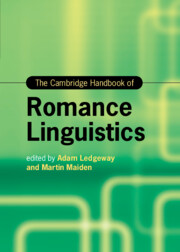Book contents
- The Cambridge Handbook of Romance Linguistics
- Cambridge Handbooks in Language and Linguistics
- The Cambridge Handbook of Romance Linguistics
- Copyright page
- Dedication
- Contents
- Figures
- Tables
- Contributors
- Abbreviations
- 1 Data, Theory, and Explanation: The View from Romance
- Part One What Is a Language?
- Part Two Phonetics and Phonology
- Part Three Morphology
- Part Four Syntax
- Part Five Semantics and Pragmatics
- Part Six Language, Society, and the Individual
- 27 Register, Genre, and Style in the Romance Languages
- 28 Contact and Borrowing
- 29 Diamesic Variation
- 30 Social Factors in Language Change and Variation
- Index
- References
29 - Diamesic Variation
from Part Six - Language, Society, and the Individual
Published online by Cambridge University Press: 23 June 2022
- The Cambridge Handbook of Romance Linguistics
- Cambridge Handbooks in Language and Linguistics
- The Cambridge Handbook of Romance Linguistics
- Copyright page
- Dedication
- Contents
- Figures
- Tables
- Contributors
- Abbreviations
- 1 Data, Theory, and Explanation: The View from Romance
- Part One What Is a Language?
- Part Two Phonetics and Phonology
- Part Three Morphology
- Part Four Syntax
- Part Five Semantics and Pragmatics
- Part Six Language, Society, and the Individual
- 27 Register, Genre, and Style in the Romance Languages
- 28 Contact and Borrowing
- 29 Diamesic Variation
- 30 Social Factors in Language Change and Variation
- Index
- References
Summary
Diamesic variation, a concept coined by variationist researchers in Italy, helps to understand the impact of media on linguistic structures and their evolution. By distinguishing medial, sociolinguistic, and functional aspects of diamesic variation, it becomes clear that media not only affect the (phonic and graphic) materiality of signifiers but also interact strongly with diasystematic variation along regional, social, and situational parameters and with variability of verbalization strategies between the poles of communicative immediacy and communicative distance. The latter, functional aspect of diamesic variation is anthropologically rooted and forms a universal, omnipresent background in the history of the Romance languages. Several paradigmatic analyses of Latin and Romance historical data show how the communicative variation between, for example, the maximal degree of familiarity between partners vs formal, public encounters, a high degree of spontaneity vs a high degree of planning, intensive involvement in a situation vs decontextualized speaking and writing determines standardization processes of elaboration, centralization, and codification as well as linguistic change ‘from below’ or ‘from above’.
Keywords
- Type
- Chapter
- Information
- The Cambridge Handbook of Romance Linguistics , pp. 870 - 897Publisher: Cambridge University PressPrint publication year: 2022
References
Selected References
- 1
- Cited by

